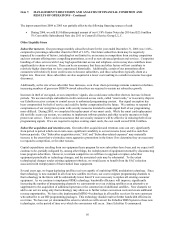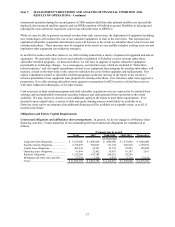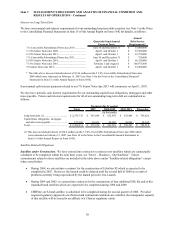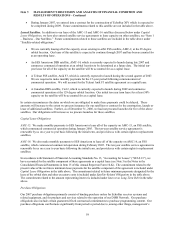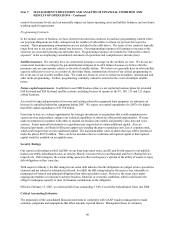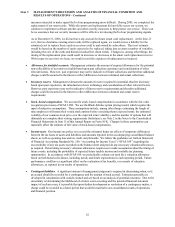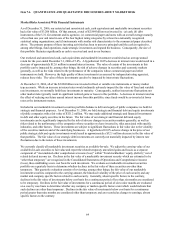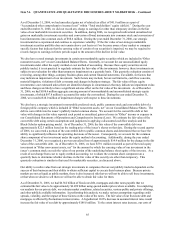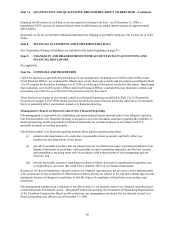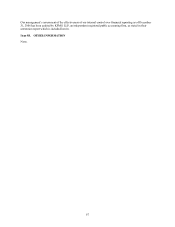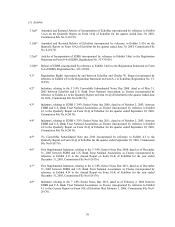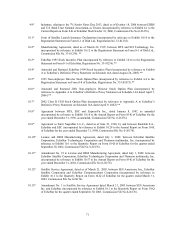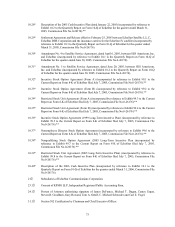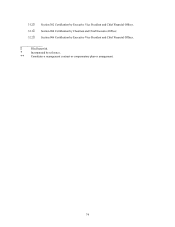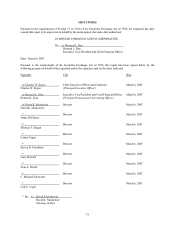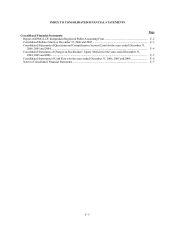Dish Network 2005 Annual Report Download - page 76
Download and view the complete annual report
Please find page 76 of the 2005 Dish Network annual report below. You can navigate through the pages in the report by either clicking on the pages listed below, or by using the keyword search tool below to find specific information within the annual report.Item 7A. QUANTITATIVE AND QUALITATIVE DISCLOSURES ABOUT MARKET RISK – Continued
66
financing would increase at such time as we are required to refinance our debt. As of December 31, 2006, a
hypothetical 10.0% increase in assumed interest rates would increase our annual interest expense by approximately
$40.5 million.
In general, we do not use derivative financial instruments for hedging or speculative purposes, but we may do so in the
future.
Item 8. FINANCIAL STATEMENTS AND SUPPLEMENTARY DATA
Our Consolidated Financial Statements are included in this report beginning on page F-1.
Item 9. CHANGES IN AND DISAGREEMENTS WITH ACCOUNTANTS ON ACCOUNTING AND
FINANCIAL DISCLOSURE
Not applicable.
Item 9A. CONTROLS AND PROCEDURES
Under the supervision and with the participation of our management, including our Chief Executive Officer and
Chief Financial Officer, we evaluated the effectiveness of our disclosure controls and procedures (as defined in Rule
13a-15(e) under the Securities Exchange Act of 1934) as of the end of the period covered by this report. Based upon
that evaluation, our Chief Executive Officer and Chief Financial Officer concluded that our disclosure controls and
procedures were effective as of the end of the period covered by this report.
There has been no change in our internal control over financial reporting (as defined in Rule 13a-15(f) under the
Securities Exchange Act of 1934) during our most recent fiscal quarter that has materially affected, or is reasonably
likely to materially affect, our internal control over financial reporting.
Management’s Report on Internal Control Over Financial Reporting
Our management is responsible for establishing and maintaining adequate internal control over financial reporting.
Our internal control over financial reporting is designed to provide reasonable assurance regarding the reliability of
financial reporting and the preparation of financial statements for external purposes in accordance with U.S.
generally accepted accounting principles.
Our internal control over financial reporting includes those policies and procedures that:
(i) pertain to the maintenance of records that, in reasonable detail, accurately and fairly reflect our
transactions and dispositions of our assets;
(ii) provide reasonable assurance that our transactions are recorded as necessary to permit preparation of our
financial statements in accordance with generally accepted accounting principles, and that our receipts
and expenditures are being made only in accordance with authorizations of our management and our
directors; and
(iii) provide reasonable assurance regarding prevention or timely detection of unauthorized acquisition, use,
or disposition of our assets that could have a material effect on our financial statements.
Because of its inherent limitations, internal control over financial reporting may not prevent or detect misstatements.
Also, projections of any evaluation of effectiveness to future periods are subject to the risk that controls may become
inadequate because of changes in conditions, or that the degree of compliance with policies or procedures may
deteriorate.
Our management conducted an evaluation of the effectiveness of our internal control over financial reporting based
on the framework in Internal Control—Integrated Framework issued by the Committee of Sponsoring Organizations
of the Treadway Commission. Based on this evaluation, our management concluded that our internal control over
financial reporting was effective as of December 31, 2006.


